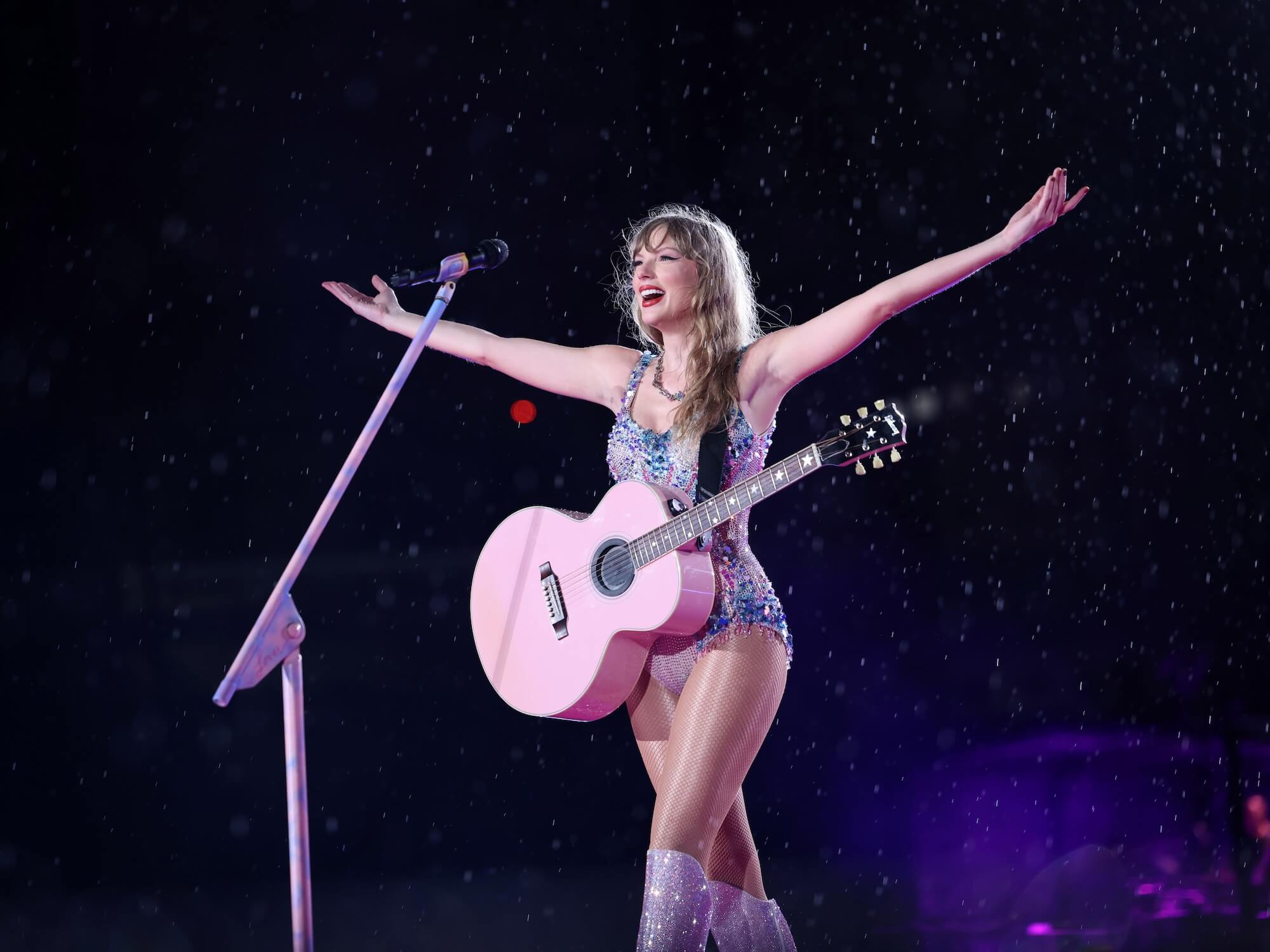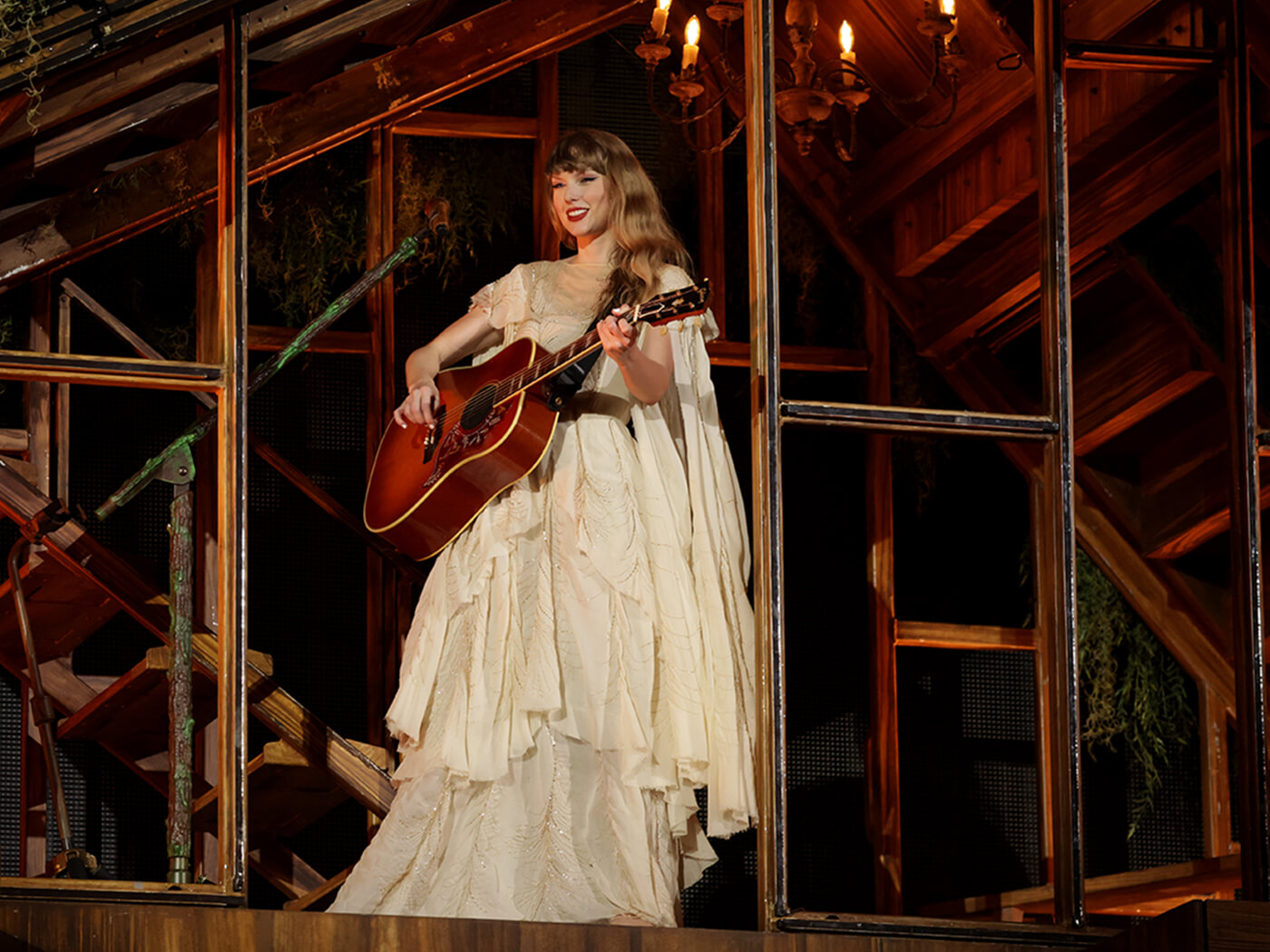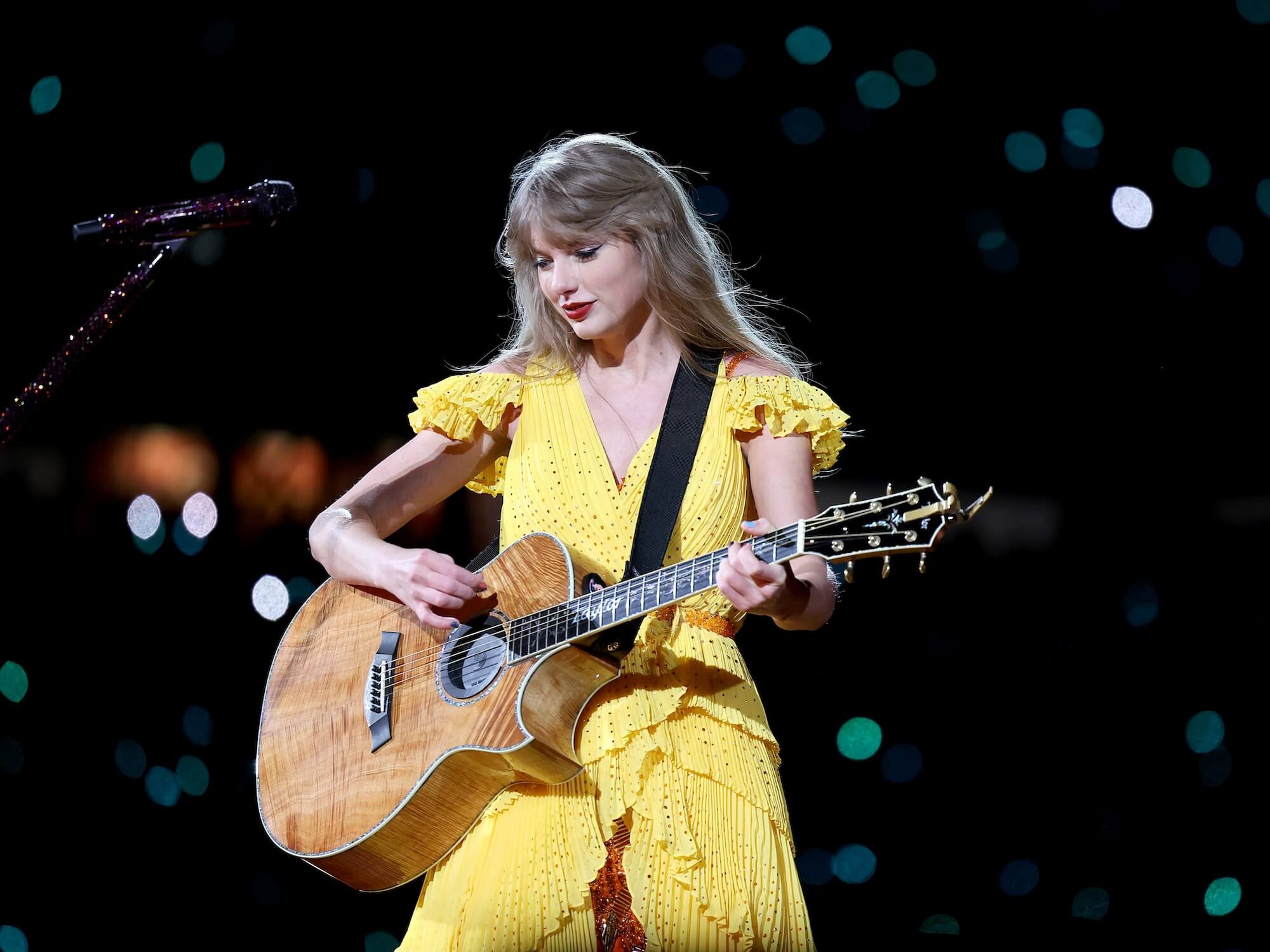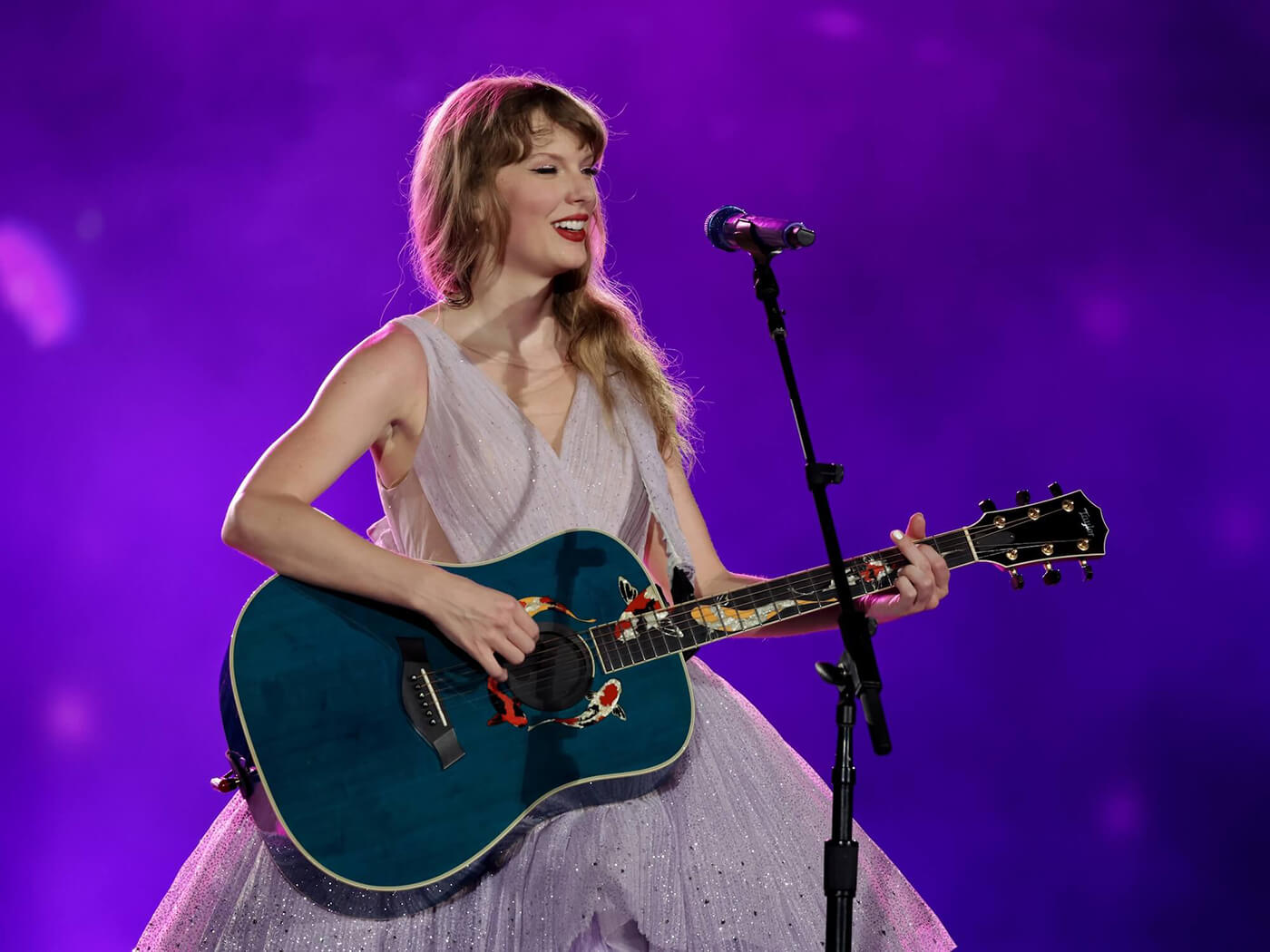How Taylor Swift is rewriting contemporary guitar music �– and making herself a modern guitar icon
From breaking industry records to boosting entire local economies with her infamous Eras Tour, Taylor Swift is not just a pop star – she’s helping make the guitar relevant and important to a whole new audience.

Taylor with her pink Gibson J-180 during the Eras Tour in Rio de Janeiro, Brazil, 2023. Image: TAS2023 via Getty Images
When we think of “guitar-oriented artists” your mind might flash to legends Jimi Hendrix, Joni Mitchell or Kurt Cobain – a trio of artists who collectively revolutionised their respective genres: rock, folk, and grunge. But what if we added Taylor Swift to that pantheon?
For some, the idea might seem borderline blasphemous; to add a one-time country singer-songwriter turned modern pop-colossus to the list of legendary names who have reshaped the instrument.
But like these great names before her, Swift is an artist who has steered and ultimately changed the face of modern popular music, and she’s done so with a guitar in her hands.
The guitar has been the single most important instrument in the history of popular music, and its power and influence in Western culture echoes to this day. Through the guitar we appreciate the Beatles zeitgeist-setting charm, the Rolling Stones’ rebellious antics, the defiant artistry of Prince and the maverick genius of Frank Zappa.
Even in an era where the guitar has gradually become less of a focal point of popular music, many of the biggest touring artists in the world are legacy acts that put guitar front and centre – Bruce Springsteen remains the living embodiment of a rockstar with his transformative heartland rock, while Paul McCartney continues to cement his status as a post-Beatles icon.
Women, too, have had their place in this timeline and rightfully deserve their recognition – from Sister Rosetta Tharpe and Joni Mitchell, to Joan Jett, Tracy Chapman and many more. It’s this legacy, this rich tradition of guitar-slinging women, that Taylor Swift would soon help to epitomise for a new generation – and make it bigger than it ever has been before.

The Guitar Foundations
Swift’s songwriting journey began with a guitar in her hands, but the case for her becoming a guitar icon in her own right really begins with her sophomore album, Fearless – a collection of 13 country-pop tunes which would take the singer to the charts for the first time. The album would spend 11 weeks on the Billboard 100 and be certified diamond by the RIAA, while the single Our Song would become her first chart-topper on the Billboard Hot Country Songs Chart.
From the off, Swift inspired a dedicated fandom – the Swifties – and this passionate support enabled her to grow and evolve rapidly as an artist, experimenting with her sound over the following three records – Speak Now, Red and 1989. These three records would push Taylor outside the realm of country and make her a genuine pop phenom – rewriting the rules for contemporary guitar pop, by catering to an audience that was predominantly young girls, teenagers and women.
These records saw Taylor become one of the biggest stars on earth, a cultural symbol who could effortlessly blur genre boundaries and push her music in any direction she felt, but one that staunchly kept guitar at its core. In an era where it was rare to hear a guitar in pop music at all – especially the kind that was aimed at a younger female audience – Swift’s music became a bastion for the instrument.
That’s not to say that Swift has limited herself, or been immune to evolving her music with trends – 2017’s Reputation saw trap beats, layered synths and rap become focal points of this new form of expression. But the guitar remained a constant force in the background – for every maximalist track like Look What You Made Me Do and Don’t Blame Me, you also found her familiar intimate singer-songwriter style on Delicate and New Year’s Day.
Swift’s intention within music changed at this point, too. She was no longer looking to prove herself but, instead, set her own narrative – and increasingly this narrative would be heavily informed by her love of guitar.

Her Folk Era
The recent evolution of Taylor Swift has seen her become more influential to guitar than perhaps ever before – a development reflected by her two most frequent collaborators over this period, Bleachers guitarist and uber-producer Jack Antonoff and The National guitarist Aaron Dessner.
On her 2019 album Lover, the musician cross-connected her styles in a pop album that felt reminiscent of her Speak Now and Red eras, but her guitar influence would be most keenly felt on sister releases Folklore and Evermore. These two records lean further than ever into Swift’s acoustic singer-songwriter background, with a turn towards guitar-driven folk music.
The intimate, stripped back style of these two records connected with an audience who, in that moment, were isolated due to the global pandemic. But it also again characterised the importance of the guitar in Swift’s music – when she wants to connect most intimately with her audience, she picks up a guitar.
Taylor’s ‘folk’ era would have a definite impact on guitar music more widely. From Noah Kahan and Lizzy McAlpine and beyond, it’s hard not to feel the influence of Swift’s monocultural power in the current surge of crossover acoustic music in the wake of Folklore and Evermore.

Owning The Instrument
Because let’s not forget that in 2024, Swift has become the most-streamed female artist in Spotify history and the first to cross 35 billion streams across her catalogue — an achievement caused by her tenth studio album, Midnights, in 2022. In 2024, her latest album The Tortured Poets Department, became the fastest album to surpass a billion streams – in just one week – and also had the single-largest sales week for a vinyl album in the modern era.
Because that’s the other side of Taylor Swift as a cultural force – the Swifties have huge cultural and commercial clout, and her championing of the guitar has real and tangible effects. According to a Fender study in 2018, 50 per cent of new guitar buyers were women. As for today, she remains a pivotal influencer to the new generation of musicians (Olivia Rodrigo, Conan Gray, Sabrina Carpenter and Gracie Abrams).

The Guitar As A Symbol
Across Swift’s wide-spanning discography the guitar has remained central to her music, even if, at times, it has taken a background role. Her ability to create a long-standing connection with guitar music (and her fanbase) has aided her in creating an emotional connection with her audience.
Even today, Swifties know the significance of her guitars. The Eras Tour has demonstrated the way she associates certain guitars with certain periods of her life, and the fans do likewise – from her Speak Now-era blue Koi Fish Taylor guitar to recreating the silver rhinestone-studded guitar she used on her Fearless tour with her currently favoured Gibson J-180. Her instruments – and especially her guitars – are more than functioning pieces but symbolic of shared album cycles, tours and connections she’s had with fans through music.
As Dr Christa Anne Bentley, Assistant Professor of Musicology at the University of Arkansas, explains, Swift is able to remain “notable” through how she has “captured an audience base” throughout her career. “The guitar has allowed her to create portable versions of her songs that she can play anywhere, and the ability to play her songs acoustically has helped her build her credibility as a songwriter,” Bentley adds. “It allows her to show that there is something there at the core of her song when all the other production is stripped away.”
As for whether Bentley considers The Tortured Poets musician part of the guitar community, she does. “I do consider Swift a guitar-centric musician,” she says. “I think her imagery is also tied to her guitar – fans have specific associations between the guitars she played at different stages of her career – it shows how much the guitar has been embedded in her own life.”
The growing legacy of Swift as a guitar hero extends deep into her discography, as Satu Hämeenaho-Fox, author of Into the Taylor-Verse suggests. The singer’s inseparable affiliation with guitar (and guitar music) puts her in line with memorable icons like Bruce Springsteen and Joni Mitchell.

For Hämeenaho-Fox, this attribute showcases her “chameleonic” as she’s able to swing between pop and guitar pop, all while honouring the varying genres of her sound. “Taylor has consistently appeared in public holding a guitar, from live shows to the occasion she surprised a pair of fans at their wedding with an acoustic performance of King of My Heart,” she says. “[It’s] a serious celebration and interrogation of her music, [where] the instrument can symbolise freedom, prowess, presence and using your voice.”
As Swift’s latest album continues to be critiqued and considered – whether we see it as a piece of autofiction or a larger-than-life literary embellishment of her legacy – the question of the singer’s guitar connection feels like unearthing a blueprint.
In 2004 the artist performed at Bluebird Cafe in Nashville – guitar in hand ��– where she was first scouted. Today, her Eras Tour has earned over $1 billion to become the highest-grossing concert tour of all time; a show that is a tribute to her chapters, many of which are centred around different coloured guitars.
Whether she’s blending moody acoustic arrangements on Evermore or speculating the trajectory of next-generation stardom on The Tortured Poets, the guitar has remained fundamental to her storytelling.
It’s with this instrument Swift has her real breakthroughs, where her regularly revisited motifs (high school, heartbreak and vulnerability) and diaristic lyrics resonate. She might not be a great technician or the creator of timeless guitar riffs (though plenty of guitar icons share one or both of these caveats) – but she has done something that all the greatest guitar legends have done – make the instrument a vital force in popular music, and inspire young people to pick up the instrument.
With that in mind, maybe it’s time we came to celebrate Taylor Swift for what she said – a modern day guitar icon.
